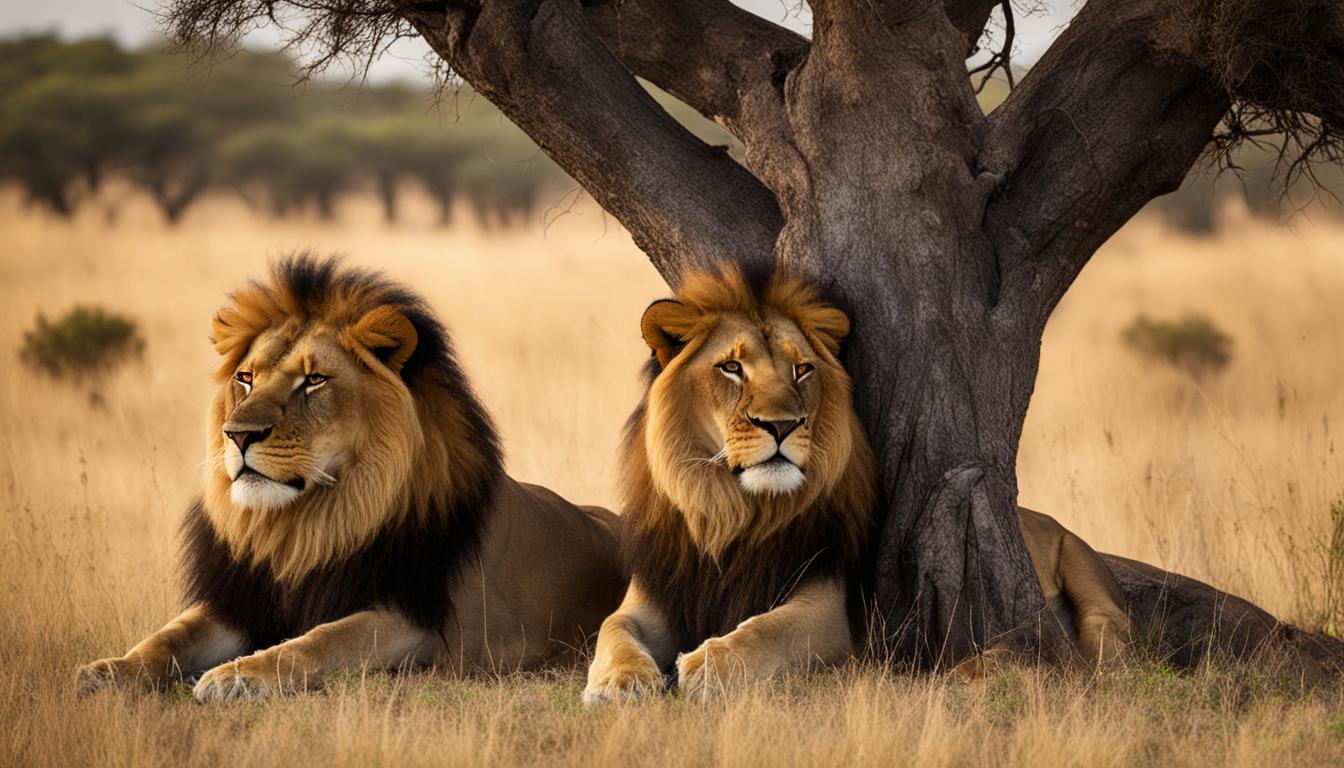Lions are fascinating creatures known for their territorial behavior and impressive habitat characteristics. In this article, we will explore how lions establish and defend their territories, shedding light on their habitat requirements and territorial behaviors.
Key Takeaways:
- Lions are highly territorial animals and occupy the same area for generations.
- They establish and defend their territories through various behaviors and characteristics.
- Lions live in prides, consisting of related females, offspring, and a coalition of resident males.
- Pride size ranges from 1-21 females, with larger prides having higher reproductive success.
- Lions actively defend their territories against other lions using vocalizations, scent marking, and physical confrontations.
Lion Pride Structure and Dynamics
In the complex social structure of lions, prides play a vital role. A pride typically consists of several related females, their dependent offspring, and a coalition of resident males. It is a fascinating system that ensures the survival and reproductive success of this iconic species.
The pride size can range from small groups with as few as four members to larger prides with around 37 members. However, the average pride size is typically around 15 individuals. The composition of a pride is dynamic, with females often recruiting their daughters into the group. Some daughters may also disperse to form new prides, contributing to genetic diversity. (Keywords: lion pride, female recruitment, pride size)
The role of males in a pride is equally important. Young males leave their birth pride and form coalitions with unrelated males. These coalitions serve as a source of protection and help in maintaining the pride’s territory. The size of the male coalition can vary from 2 to 10 individuals, with larger coalitions having higher reproductive rates. This cooperative behavior enhances the pride’s stability and provides better opportunities for hunting and fending off intruders.
Group Living in Lion Pride
Group living within a lion pride has significant advantages. Females within the same pride tend to breed at similar rates and often stay together throughout their lives. This close bond allows them to protect their offspring from attacks and reduce the risk of infanticide. Male lions, on the other hand, may spend only a few years in a given pride but remain with their coalition partners. This cooperative structure ensures the survival and well-being of the pride.
Lions demonstrate remarkable social behaviors and form close-knit communities. Understanding the dynamics of pride structure is crucial for their conservation and for fostering a harmonious coexistence between lions and humans.
| Pride Size | Female Recruitment | Reproductive Rates |
|---|---|---|
| Small Pride | Females recruit daughters and form new prides | Lower reproductive rates |
| Large Pride | High recruitment within the pride | Higher reproductive rates |
Infanticide in Lion Territories
Infanticide is a significant phenomenon in lion territories, involving the killing of young cubs by incoming male coalitions. When a new group of males takes over a pride, they face a reproductive challenge from the existing cubs. To ensure their own reproductive success, these incoming males often kill all the young cubs in their new pride. In fact, infanticide accounts for approximately 25% of all cub deaths. This behavior prompts the females to mate again sooner, as they will not mate until their cubs reach a certain age.
Mothers actively defend their offspring against attacks from incoming males, reducing the risk of infanticide. They also employ a strategic tactic to incite competition between rival males, ensuring that they only conceive again after the largest available coalition has become resident in their pride. Additionally, female lions will kill the cubs of rival prides but spare the cubs of their pridemates, further ensuring the survival of their own offspring.
“When a new male coalition takes over a pride, the first reproductive challenge they face is from the existing cubs. Infanticide is a male strategy to ensure their own genes are passed on by eliminating the offspring of their competitors.”
For the young subadults who manage to escape the infanticidal males, survival becomes a great challenge. They become outcasts, forced to fend for themselves, and are at risk of starvation and attacks from other prides. Infanticide thus plays a significant role in the dynamics of lion territories and the survival of cubs in these social structures.
| Infanticide in Lion Territories | Mechanism | Impact |
|---|---|---|
| Males kill young cubs | Ensures own reproductive success | 25% of cub deaths |
| Females defend offspring | Reduces risk of infanticide | Increases survival for own cubs |
| Females incite competition | Controls timing of reproductive cycles | Ensures largest coalition dominates |
| Surviving subadults become outcasts | Risks starvation and attacks | Disrupted social dynamics |
Communal Cub Rearing in Lion Prides
In lion prides, communal cub rearing is a fascinating behavior that provides numerous benefits for the survival and well-being of the young. When a male takeover occurs in a pride, the reproductive clocks of the females are reset, resulting in synchronous births. Mothers of similarly aged cubs form a crèche, or a group, and remain together for 1-2 years. This communal approach to raising cubs offers several advantages.
Firstly, within the crèche, lionesses often nurse each other’s cubs, prioritizing their own offspring and those of close relatives. This nursing behavior ensures that all cubs receive the necessary nutrition for their growth and development. Interestingly, mothers of singleton cubs produce the same amount of milk as mothers with larger litters, indicating their willingness to contribute to the communal effort.
Moreover, forming a crèche provides improved protection against infanticide. By grouping together, the lionesses are better able to defend their young against extra-pride males seeking to establish their dominance. Although the crèche can only withstand brief male incursions, the resident males also play a crucial role in patrolling the pride territory and repelling outside males, further enhancing the protection of the cubs.
The Benefits of Communal Cub Rearing in Lion Prides
- Shared nursing ensures all cubs receive adequate nutrition
- Improved protection against infanticide
- Enhanced defense through the role of resident males
“The communal cub rearing behavior in lion prides illustrates the social complexity and cooperative strategies exhibited by these remarkable creatures. By working together, lionesses ensure the survival and future success of their offspring, fostering a strong sense of community within the pride.”
Overall, communal cub rearing in lion prides represents a remarkable example of cooperative behavior within the animal kingdom. This strategy not only benefits individual cubs but also strengthens the social bond among pride members. By understanding and appreciating these unique behaviors, we can gain a deeper insight into the intricate dynamics of lion prides and contribute to their conservation and coexistence with humans.
| Benefits of Communal Cub Rearing |
|---|
| Shared nursing |
| Improved protection against infanticide |
| Enhanced defense through resident males |
Lion Territory and Territorial Behaviors
Lions are highly territorial animals, and their territories play a crucial role in their survival and reproductive success. Territory defense is essential for access to resources such as prey abundance, water sources, and denning sites. Lions actively mark and protect their territories using a combination of scent marking and vocalizations.
Scent marking is a key territorial behavior in lions. They use scent glands located on their faces, paws, and tails to leave olfactory signals on rocks, trees, and grass. This marking system allows lions to communicate their presence and claim ownership of their territory. It also serves as a warning to other lions to stay away. By scent marking, lions establish clear territorial boundaries and reduce the likelihood of confrontations with intruders.
Vocalizations, especially roaring, are another important territorial behavior in lions. The lion’s roar is not only a majestic sound but also serves as a territorial display. Roaring can be heard from a distance of at least five kilometers and serves to announce the presence of the pride and deter potential intruders. Lions are able to count the number of individuals in a roaring group, allowing them to assess the competition and respond accordingly. If they confidently outnumber intruders, lions will challenge them to defend their territory.
SUMMARY:
- Lions establish and defend their territories through a combination of scent marking and vocalizations.
- Scent marking involves leaving olfactory signals on rocks, trees, and grass, effectively communicating ownership of the territory.
- Vocalizations, including roaring, serve as territorial displays and deter potential intruders.
- Lions are skilled at assessing the number of individuals in a roaring group, allowing them to gauge the competition and respond accordingly.
- Territory defense is crucial for lions to secure resources such as prey abundance, water sources, and denning sites.
| Territorial Behaviors | Description |
|---|---|
| Scent Marking | Lions use scent glands on their faces, paws, and tails to leave olfactory signals on rocks, trees, and grass, effectively marking their territory and reducing the likelihood of confrontations with intruders. |
| Vocalizations | The lion’s roar serves as a territorial display, announcing the presence of the pride and deterring potential intruders. Lions can assess the competition by counting the number of individuals in a roaring group. |
Lion Pride Structure and Protection
A lion pride is a complex social structure consisting of several generations of lionesses, a smaller number of breeding males, and their cubs. The size of a pride can range from 4 to 37 members, with an average size of around 15. The pride leader, typically a male, plays a crucial role in safeguarding the pride, along with other males in the pride. Lions form prides to improve hunting efficiency, protect against intruders, and defend their territories.
Understanding the composition of a lion pride is essential to comprehending their social dynamics. Female lionesses within a pride are often related, with some being sisters or cousins. They form the foundation of the pride and are responsible for hunting and raising the cubs. Males, on the other hand, are usually unrelated and join the pride through coalitions. These males play a vital role in defending the pride and ensuring the survival of their offspring. Their presence also helps deter rival males from attempting to take over the pride.
Lion conservation is of paramount importance due to the significant decline in lion populations. Studies have shown a 50% decrease in lion numbers since 1995, leading to their classification as a vulnerable species on the IUCN Red List. Various factors contribute to this decline, including illegal trade in lion body parts and trophy hunting. Efforts to conserve lions focus on protecting their natural habitats, mitigating human-wildlife conflicts, and implementing sustainable tourism practices. These initiatives are crucial in preserving lion populations and ensuring their long-term survival in the wild.
| Pride Composition | Male Role |
|---|---|
| – Several generations of lionesses | – Safeguarding the pride |
| – Smaller number of breeding males | – Defending the pride |
| – Cubs | – Ensuring the survival of offspring |
As lion populations continue to decline, it is imperative that we prioritize their conservation. By understanding the unique structure and dynamics of lion prides, we can develop effective strategies for their protection. Preserving lion habitats, combatting illegal wildlife trade, and promoting sustainable practices are all essential steps towards ensuring the survival of these majestic creatures in the wild.
Lion Strength and Agility
Lions are renowned for their incredible strength and agility. Adult male lions typically weigh between 170-230 kg (370-500 pounds) and measure around 1.8-2.1 meters (6-7 feet) in length, excluding the tail. Females are slightly smaller, weighing 120-180 kg (260-400 pounds) and measuring about 1.5 meters in length. Their powerful build enables them to leap three times higher than a human, showcasing their remarkable athletic abilities.
In the wild, lions primarily hunt medium to large-sized hoofed animals such as wildebeests, zebras, and antelopes. They employ a combination of stealthy stalking and cooperative hunting techniques to bring down their prey. Their muscular bodies and sharp claws allow them to overpower and take down even larger, robust herbivores.
“The strength of a lion cannot be underestimated. They are powerful predators, capable of fending off attacks from rival predators such as hyenas,” says Dr. Jane Wilson, a wildlife biologist specializing in lion behavior.
“Lions’ hunting skills and exceptional strength are finely tuned for survival in the African wilderness. Their remarkable agility allows them to maneuver swiftly and silently, ensuring successful predatory pursuits,”
– Dr. Jane Wilson
| Lion Attribute | Measurements |
|---|---|
| Adult Male Weight | 170-230 kg (370-500 pounds) |
| Adult Female Weight | 120-180 kg (260-400 pounds) |
| Adult Male Length (excluding tail) | 1.8-2.1 meters (6-7 feet) |
| Adult Female Length (excluding tail) | About 1.5 meters (5 feet) |
| Leap Height | Three times higher than a human |
Conclusion
Lions establish and defend their territories through a complex social structure and territorial behaviors. They live in groups called prides and actively mark and protect their territories against intruders. Lions rely on a combination of scent marking, vocalizations such as roaring, and physical confrontations to establish territorial boundaries.
The size and quality of a lion’s territory depend on factors such as prey abundance and access to vital resources. Lions exhibit communal cub rearing behaviors, forming creches to protect their young against infanticide. Conservation efforts are crucial to preserving lion habitats and ensuring their survival, as lion populations have significantly declined.
By understanding the unique characteristics and behaviors of lions, we can appreciate these majestic creatures and work towards their conservation and coexistence with humans in harmony.
FAQ
How do lions establish and defend their territories?
Lions establish and defend their territories through various behaviors such as scent marking and vocalizations. They actively mark their territory using urine, feces, and scratch marks on trees. Additionally, lions use roaring as a territorial display, which can be heard from a distance of at least five kilometers. When intruders enter their territory, lions will challenge them if they confidently outnumber them.
How does group living work in a lion pride?
A lion pride consists of related females, their offspring, and a coalition of resident males. Typically, about six related females and 2-3 resident males make up a pride. Daughters are usually recruited into their mothers’ pride, while some may disperse to form new prides. Pride size can range from 1-21 females, with mid-sized prides having the highest reproductive rates. Young males leave their birth pride in search of unrelated mates and form coalitions.
What is the occurrence of infanticide in lion territories?
Infanticide is a common behavior observed in lion territories. When a new male coalition takes over a pride, they face a reproductive challenge from the existing cubs. To ensure their own reproductive success, incoming males often kill all the young cubs in their new pride. Infanticide accounts for a quarter of all cub deaths. Mothers of surviving cubs will not mate again until their offspring reach a certain age, reducing the risk of infanticide.
How do lion prides protect their offspring against attacks?
Female lions play a crucial role in protecting their offspring against attacks. They directly defend their cubs and reduce the risk of infanticide by inciting competition between rival males. By doing so, they ensure that they only conceive again after the largest available coalition has become resident in their pride. Female lions will also kill the cubs of rival prides but spare the cubs of their pridemates.
How does communal cub rearing work in lion prides?
Lions practice communal cub rearing by forming crèches. Mothers of similarly aged cubs will come together and remain in the same group for 1-2 years. Crèche-mates often nurse each other’s cubs, with priority given to their own offspring and the offspring of close relatives. The primary advantage of forming a crèche is improved protection against infanticide. A group of females is better able to defend their young against extra-pride males.
How do lions mark their territories and display territorial behaviors?
Lions mark their territories through scent marking, using urine, feces, and scratch marks on trees. They also utilize vocalizations, including the iconic roar. Roaring is a territorial display that can be heard from at least five kilometers away. Lions are able to count the number of individuals in a roaring group and will challenge intruders if they confidently outnumber them. Territory size and boundaries depend on factors such as prey abundance, water availability, and denning sites.
What is the structure of a lion pride and how do they protect themselves?
A lion pride consists of several generations of lionesses, related or unrelated, a smaller number of breeding males, and their cubs. Pride size can range from 4 to 37 members, with an average size of around 15. The pride leader, typically a male, has the primary role of safeguarding the pride, along with other males in the pride. Lions form prides to improve hunting efficiency, protect against intruders, and defend their territories. Conservation efforts are crucial to preserving lion habitats and ensuring their survival, as lion populations have significantly declined.
What are some of the physical characteristics that make lions formidable predators?
Lions are known for their strength and agility. Males can weigh between 170-230 kg (370-500 pounds) and measure around 1.8-2.1 meters (6-7 feet) in length, excluding the tail. Females are smaller, weighing 120-180 kg (260-400 pounds) and measuring about 1.5 meters in length. Lions have the ability to leap three times higher than a human and are skilled predators. They primarily hunt medium to large-sized hoofed animals such as wildebeests, zebras, and antelopes, using stalking and cooperative hunting techniques.











